Interior design isn’t just about making a space look good. Design needs to pique emotions, and good design should always make you feel a certain way. Mediterranean design instantly soothes and relaxes, in the same way that Art Deco design should inspire feelings of excitement.
There are hundreds of interior design trends, and all of them can be difficult to get right, especially when you don’t know where to start. Looking at breakthrough design styles can help to point you in the right direction when it comes to styling your home in a way that works for you, especially if you like to stay on trend.
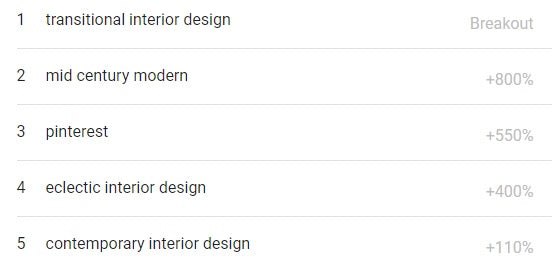
Google Trends data shows us that searchers are going crazy for certain design trends, including Transitional, Mid Century Modern, Eclectic and Contemporary styles.
Even though Google gives us an indication of what is being searched, Instagram shows us the styles that are really resonating with the public.
With 145 million posts under the #interiordesign hashtag and counting, this platform is quickly becoming a reliable way to check on the styles that people are getting excited about. It’s the 21st century’s answer to flicking through an interior design mag.
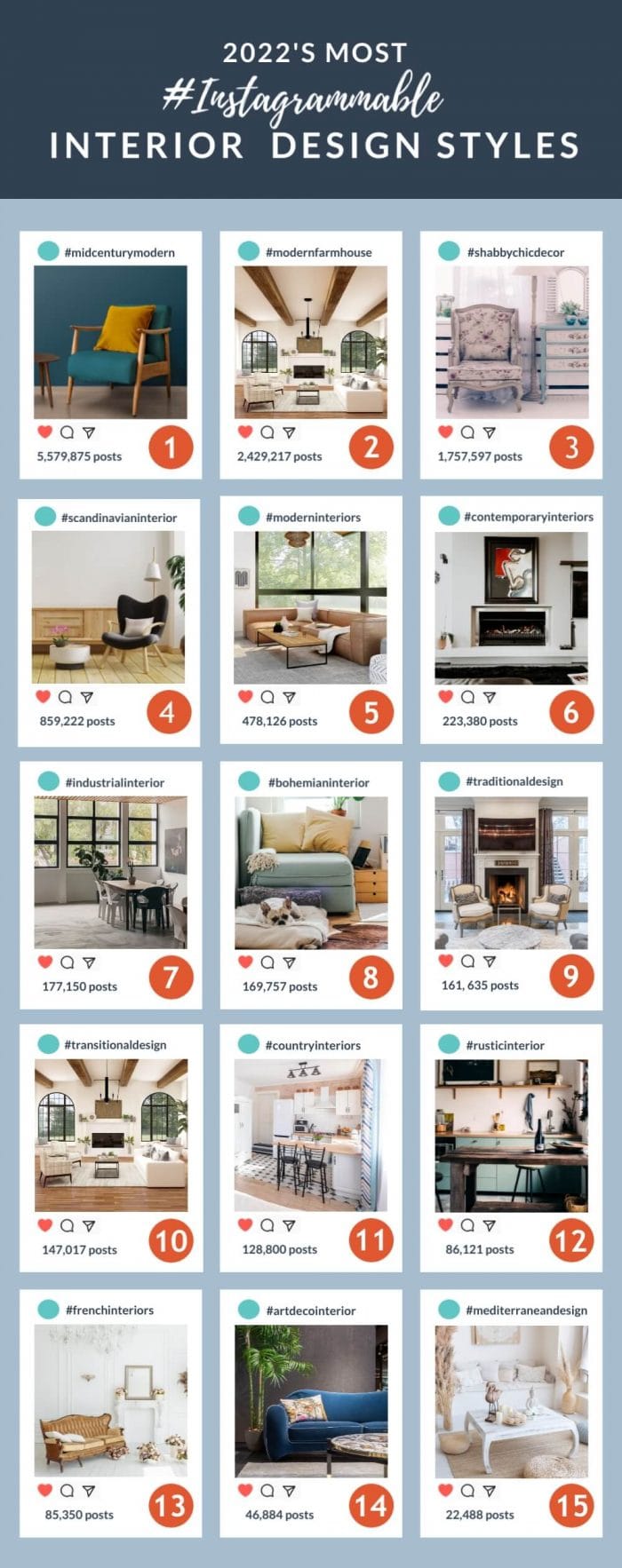
Our research shows us that #midcenturymodern is the most Instagrammable interior design style, followed by #modernfarmhouse and #shabbychic décor.
We’ve done a deep dive into these popular design styles to help you decide which you think is best for you.
#1 Mid-Century Modern
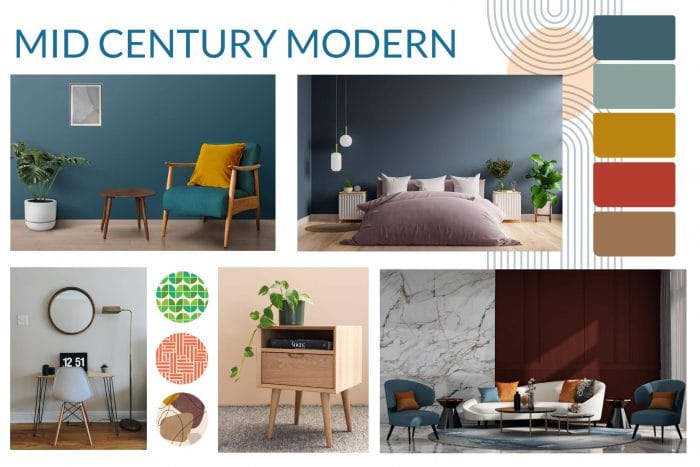
Mid-century modern is a mishmash of design styles that peaked between 1933 and 1965. Muted yet daringly bold colours are punctuated by stunning vintage finds, giving any mid-century modern space a deliciously unique appeal. This is a style for those who want to stand out, whilst appreciating the comfort that comes with familiarity. If you look at any interior designer’s playbook, you’ll know that architecture plays an important role with this style.
Nooks, crannies, and archways provide space for the small, but impactful, details that can make or break the flow of a space. But the real stars of the show are the painstakingly gathered pieces of furniture. Mid-century takes odd, ‘outdated’ pieces, and stitches them together seamlessly. Keep an open mind and be prepared to scour auction houses, charity shops, and local selling sites to get the pieces you need for a mid-century modern home.
Chunky navy and white stripes would overwhelm most spaces, but here they provide an almost necessary backdrop for a large, 60s-style white sofa. The room is full of personality, and cohesion is achieved with a large, curved lamp that provides a bridge between the personality-heavy shelves and the focal point of the seating area.
#2 Modern Farmhouse

Modern farmhouse design is exactly what it sounds like – it takes the traditional features of a farmhouse or barn and brings them into the 21st century, highlighting raw, classic features and adding plush, modern-day comforts. To fully understand this interior style, you must turn your back on the cosy cottages of the UK countryside and take a trip to southern America, where converted ranches and new houses built on vast expanses of land owe themselves to lofty ceilings and open, airy spaces.
The common whitewashed walls and bare wooden beams border on minimalist, making the modern farmhouse style a firm friend of those who love uncluttered, easy to maintain spaces. Couple functional furniture, minimal decorations and clever home storage solutions to achieve this back-to-basics, welcoming style.
Airy, ‘fresh’ spaces are a hallmark of Modern Farmhouse interiors, and this room showcases this beautifully. High beams and white, sparse walls create a simple background, coupled with functional but comfortable furniture. This open plan kitchen/living space owes itself perfectly to busy family life.
#3 Shabby Chic
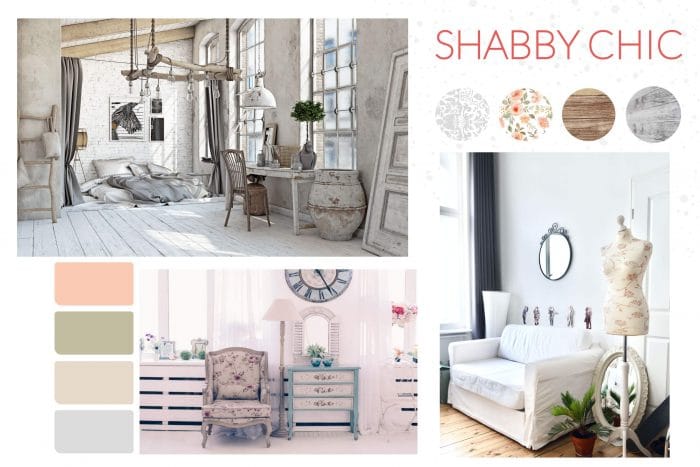
Combine distressed furniture with floral prints and chintzy accessories, and you get shabby chic interior design. This pseudo-French style is the epitome of femininity in design and embraces the idea of reusing and repurposing old furniture without stripping the history out of it.
Like mid-century modern, you need to be prepared to hit up the charity shops and vintage furniture sales if you want to achieve shabby chic. Pre-loved furniture is at the top of the heap, and every mark, scuff, and scratch, tells a story. If you can’t get a hold of anything distressed enough for your tastes, a few layers of pastel or off-white paint and some fine-grained sandpaper will set you on the right path.
The kitchen is the heart of the home, which makes it the perfect place to deploy shabby chic design. Above, we see traditional frilled fabrics encompassing pale wooden features, inviting you in to break out the cookware and whip up a feast. It borders on feeling old-fashioned, but in a comforting way.
#4 Scandinavian
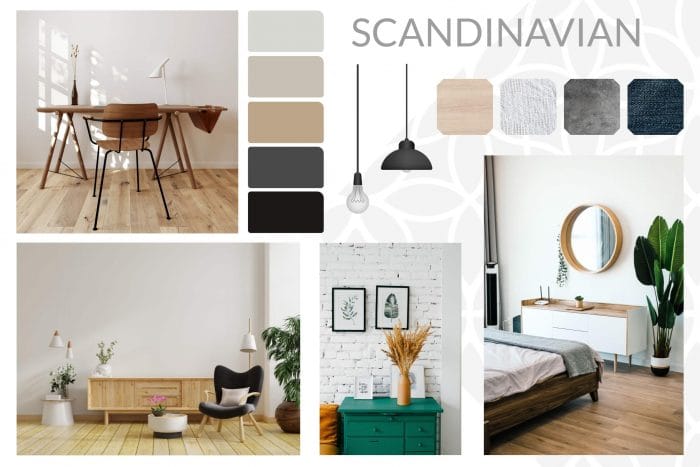
In Scandinavian design, functionality is key. Scandi design is a clutter free dream that doesn’t deprive you of comfort or practicality. Drawing inspiration from favoured design styles from across Europe, you’ll find elements of Scandinavian design everywhere you look. From restaurants to your dentist’s waiting room, the uncomplicated essence of this design style means it can be applied anywhere without facing the threat of becoming outdated.
This is one of the few rare interior design styles where less is most definitely more. Natural elements provide a serotonin boost to make a room instantly welcoming, whilst occasional pillars of colour in the form of feature walls, painted cabinets, and soft furnishings convey the message that simple does not equal boring.
A simple dining room, incorporating all elements of classic Scandinavian design. The simplicity of the room is broken up by an eclectic collection of abstract art pieces adorning the wall, adding personality to the space.
#5 Modern
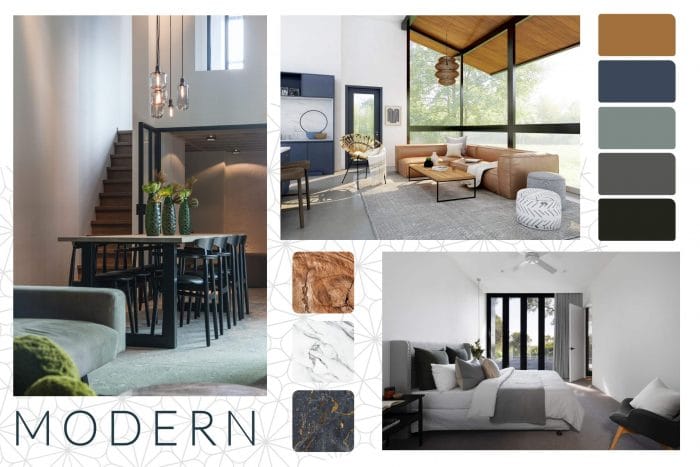
Modern interior design is a symphony of unique, stand-out art pieces, integrated technology, and functional, comfortable furniture. Natural and artificial lighting is used to create an atmosphere, allowing the unique ability to transform a light, airy room into a cosy, intimate space when the sun starts to set. White and grey linens and cottons continue the crisp and clean aesthetic, and every detail is carefully considered; chosen to create multiple ‘wow’ factors.
Many people are under the false impression that modern interior design has no personality, but this is far from the truth. The bare nature of it allows simpler features like hanging, pendant lights, and subtly textured, upholstered pieces to have a voice. Modern interior design speaks for itself.
The space above includes everything that we love about modern interior design. Simple furnishings are framed by high ceilings, and the eyes are drawn to a unique piece of wall art.
#6 Contemporary
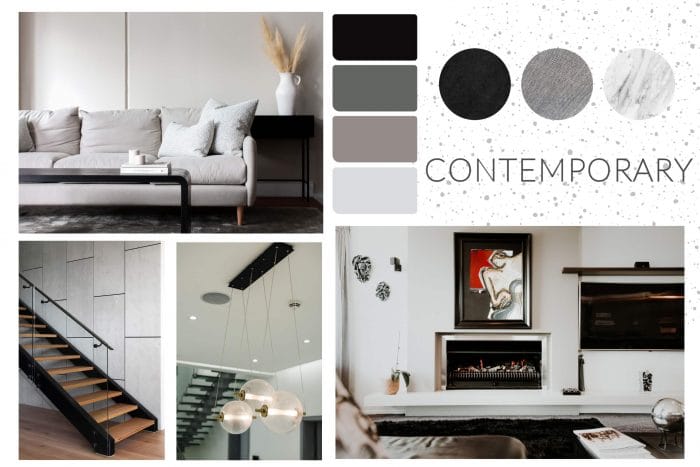
Contemporary interior design invites you to fall in love with the concept of minimalism. Unique, bold furnishings and borderline futuristic architecture makes up for a monochromatic, or black and white, colour scheme. This absence of colour means that your eye is drawn to the trivial details – cleverly placed ornaments which might blend into the background of any other space are brought to the forefront of your attention.
This is an interior design style where functional pieces double up as art. Impressive hanging light fixtures and roaring, recessed fireplaces are made to impress whilst providing real value to the space. Even staircases are treated as a focal point and are not boxed in. In modern interior design, everything has its place, and all features work together cohesively.
Check out our guide on displaying memorabilia without looking cluttered to achieve this look.
Every element of this contemporary space is chosen to make an impression. Even the architecture has been considered here – a space has been carved out of a jutting corner for an impressive fireplace, and a pillar accentuates the tallness of the ceilings.
#7 Industrial
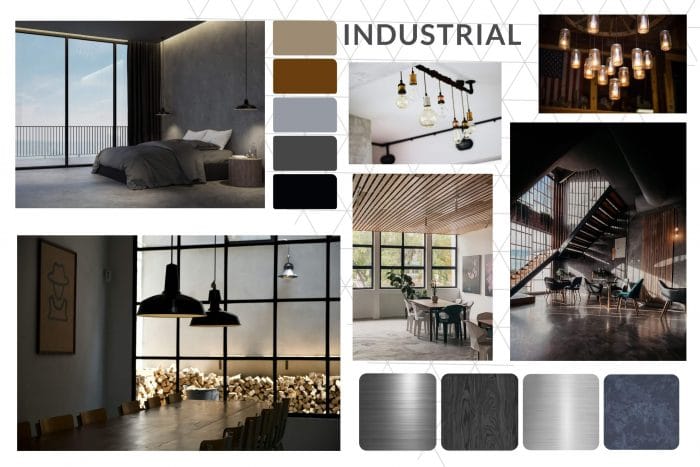
Industrial design embraces the rawness of metal, wood, and stone. It fits in perfectly in mill conversion apartments and other older buildings where exposed pipework and wooden beams are the norm. We’ve noticed that industrial design is usually affiliated with lofts and city living, but it can work beautifully in any space. It’s easy to achieve by making quick swaps; replace modern tables with reclaimed wood pieces, get rid of the clunky built-in wardrobes and choose a simpler clothes rail.
This design style is unique in that it shows off its imperfections rather than trying to cover them up. It strips back the skin of modern renovations and exposes the bones of a building, exposing its history and well-loved walls. Though it may look dark and gloomy from the outside, industrial spaces manage to feel familiar and welcoming.
This open living space is a perfect example of industrial design and architecture. The designer has chosen to restore old, wooden flooring and has left metal structural features uncovered – utilising them as a focal point of the room rather than hiding them behind panelling.
#8 Bohemian
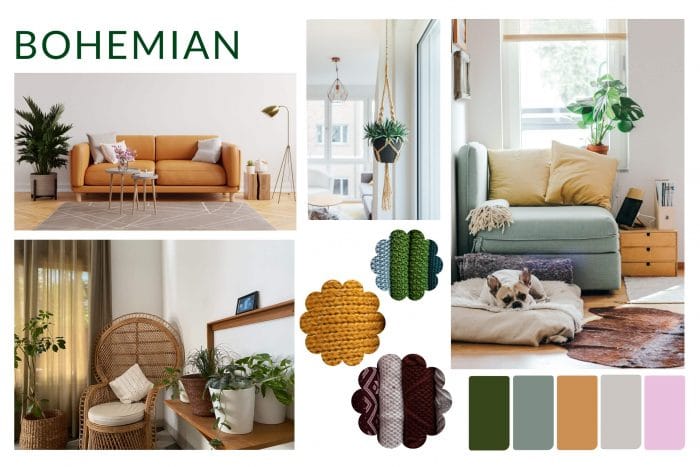
Free-thinking creativity melds together with cultural expression in Bohemian design. Bohemian interiors welcome you home, whilst simultaneously taking you across the oceans and thrusting you into another culture. Textures, colours, and patterns are borrowed from around the world to create a delectable visual experience, with new details revealing themselves at every turn.
Natural elements are important in Bohemian spaces so there is an absence of cheap, mass-produced items. Instead, you’ll find cosy cottons and crisp linens living alongside wood and wicker furnishings – all pieces responsibly sourced, repurposed, or collected whilst travelling. These spaces make you want to hop on a long-haul flight to somewhere balmy and exotic.
A muted colour scheme is centre stage in this Bohemian bedroom. Repurposed pallets and large plants provide a natural appeal, whilst a collection of different fabric textures – from the patterned rug to olive green linen bedding – soothe the mind and inspire feelings of cosiness. Soft natural light adds a much-needed element of freshness to this space.
#9 Traditional

Nothing looks out of place in traditional interior design. Every element of every room is expected, allowing for a natural, easy flow. It is uncomplicated in a unique way, and despite the heavy textures and opulence, strong pieces of furniture show you exactly what the purpose of a space is, stopping you from becoming overwhelmed. As the name would suggest, traditional design is rooted in history, and you can feel the influence of past years when you step into one of these spaces.
Carved, heavy wooden furniture couples together with intricately woven fabrics, specially selected ornaments, and intricately patterned rugs to create spaces that are fit for royalty. Think upper-class townhouses and wealthy country estates and you’ll land squarely in the middle of traditional interior design.
This hallway exudes the principles of traditional design, providing a warm welcome for visitors. A large, woven rug covers the floor, topped off with a dark wood console. A wrought-iron light fixture hangs from the ceiling, and the stairway wall is covered in a clever display of fine art.
#10 Transitional
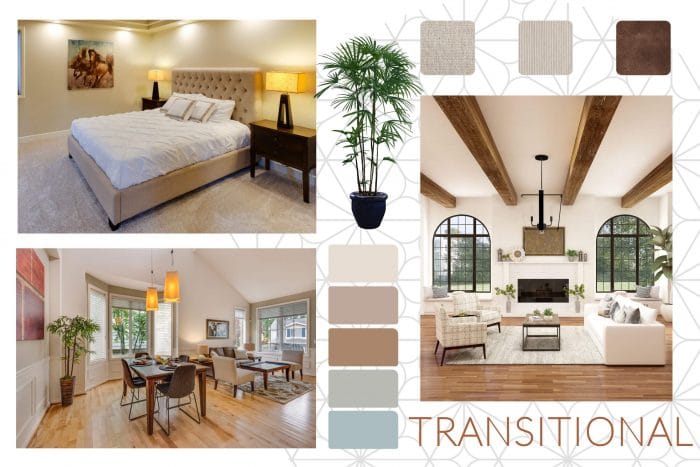
The beauty of interior design is that there are no set rules. This is obvious in the transitional design style – a clever, understated mixture of traditional and modern interior design. It takes the outdated historical features of traditional design and pulls them into the modern day, replacing intricate patterning with less complex stripes and tartans, and reducing the weightiness of the heavy wooden furniture that is typical of traditional design.
Transitional design is easy to replicate by taking advantage of existing traditional architecture and older furniture and adding a modern twist. When done properly, this cohesive mix creates a warming, sophisticated space that prioritises function.
This transitional space highlights the traditional features of the room, like the fireplace and bay window, and makes them shine with modern materials and shapes.
#11 Country
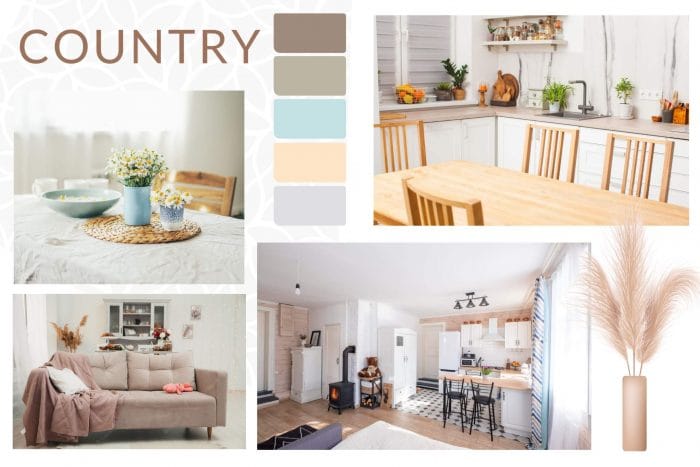
You don’t have to live rurally to be inspired by the nuanced beauty of country design. Take your mind away from the kitsch floral curtains and knitted tea cosies that the phrase ‘country-living’ used to describe – new age country design is all about locating the simpler, natural elements of rural living and introducing them to a modern space.
This is a design style that makes any room feel like home. Neutral, featherlight colours come together with natural features to inspire a timeless atmosphere, without the knitted egg baskets and frilly doilies that you might find in your grandmothers’ kitchen. Finding inspiration in 1900s farm houses, this design style strips back the meaning of country to its bare bones, serving up light wooden furnishings and basic fabrics as a blank canvas for memories to take place in.
This small snippet of a living space encapsulates many stunning features of country design and comes across as effortlessly stylish. A cluster of ornaments on a shabby chic inspired side table add a complex layer to this room, which is full of subtly textured, cosy fabrics.
#12 Rustic
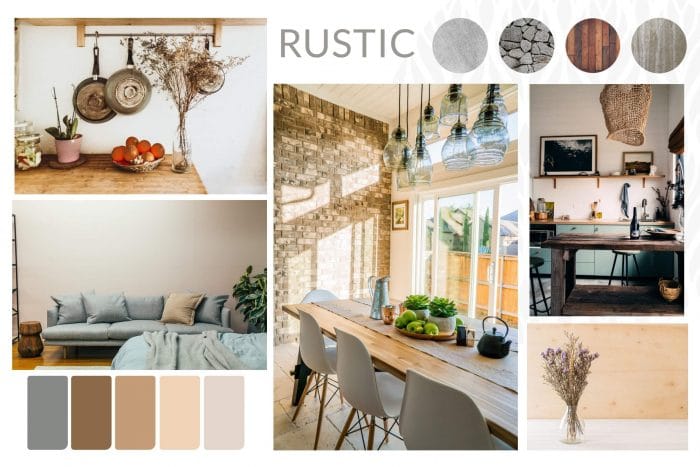
Step out into nature without ever having to leave the comfort of your home. Rustic interior design is one of the rawest and realest forms of design. It is full of exposed brick, stone, wooden beams, and unfinished surfaces. In rustic design, lakeside log cabin vibes meet country-casual, creating a light, clean look that is balanced by aged furniture and an earthy colour palette.
The beauty of rustic design is that there are dozens of directions that you can go with it. Throw yourself into the aged aesthetic and choose ancient wooden features, or keep it clean by incorporating elements of Scandinavian design that marry beautifully with dried flowers and groups of wall mounted, rustic ornaments. Whichever path is taken with rustic design, you can be sure that nature is always at the heart of it.
Rustic meets modern design in this example. Impressive, exposed brick walls and raw wooden beams meet sleek furniture in the middle, creating an impressive, open space to be admired.
#13 French
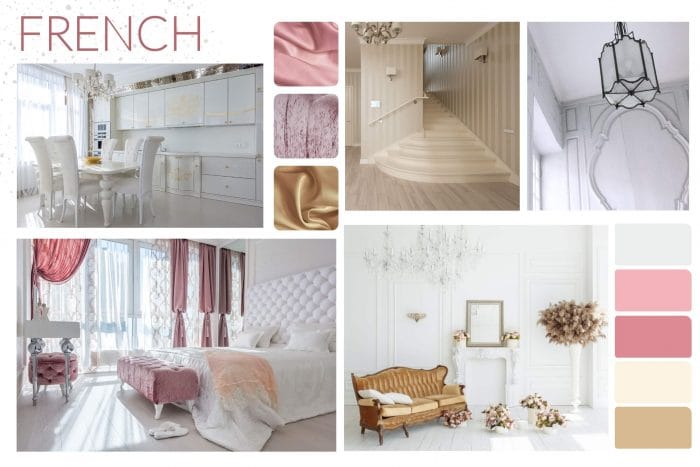
Shabby chic meets traditional features in this laid-back interior design style. Bare walls and minimal furnishings are interwoven with regency-style features. A pop of crushed velvet here, and a silk upholstered chair there comes together to make a sophisticated space.
There is nothing overly complicated about French interior design; it leaves backdrops neutral and plain, allowing stand-out features and furnishings to speak for themselves.
Moulded wall panels are a common feature, giving a nod to the historical, architectural features found in the European country manors and mansions that this style is inspired by. It’s the perfect design type for bedrooms and kitchens, places where you want to add a touch of luxury and refinement.
Modern furniture provides a stylish aspect, but they don’t take anything away from the traditional French elements present in the rest of the room. A decorative fireplace and a moulding-cladded mirror provide a welcome backdrop for this French interior inspired room.
#14 Art Deco

When it comes to art deco, there is no such thing as too quirky, or too ‘out there’. Drawing inspiration from the avant-garde design flares of the 20s, 30s and 40s, art deco is the epitome of uniqueness in interior design. Think of The Great Gatsby with its roaring 20s apparel, glamour and storybook glitz, and you’ll get an idea of what art deco interiors encompass.
Cover walls with rich, jewel-like colours and complement these with weird and wonderful furniture that would look at home in a modern art gallery. Or tone it down and focus on geometric shapes and metallic features for a sleeker, mysterious look. Bring your art deco interiors into the 21st century with neon tube lighting, using technology to make a statement. These spaces exude confidence.
This space showcases the ‘in your face’ uniqueness of art deco design. Soft pinks are accentuated by bold golds, geometric patterns, and a smattering of black and white. A playful flamingo print covers the wall – injecting fun and daring into the room.
#15 Mediterranean
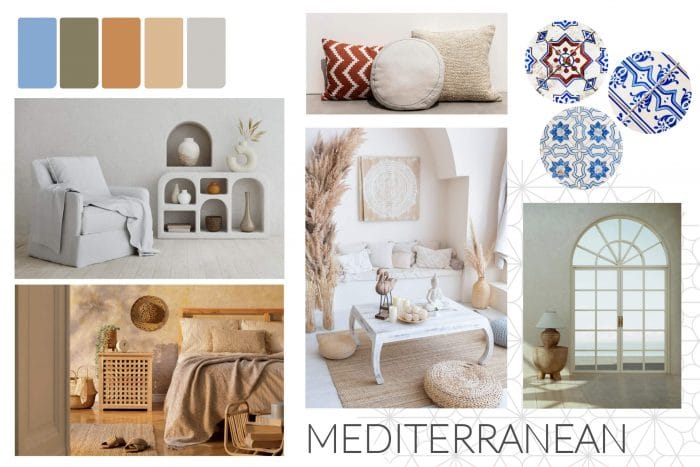
Mediterranean interior design inspires the same feelings of rest and relaxation that you get when you are on holiday. It is uncomplicated, and is drawn together with a refreshing, neutral colour scheme. Natural materials bring you straight to a sleepy, coastal, Mediterranean town – inspiring thoughts of soft sandy beaches and worn down piers. Decorative tiling adds a unique cultural element and breaks up any potential monotony.
This design style turns its back on sharp edges and corners – think of arched windows and curved shapes. In Mediterranean design, it appears that gentle, rolling waves have worn away anything sharp; nothing is unexpected or shocking to look at. The rustic energy you draw from Mediterranean spaces has the unusual ability to make you feel right at home, whilst transporting your mind to thoughts of a long, well-deserved holiday.
A Mediterranean inspired space should draw you in easily, and this space does just that. Soft materials adorn the sofa and chair, and bright sunlight spills across the room. A natural element is included in the form of a cactus, giving the area a fresh feeling.
